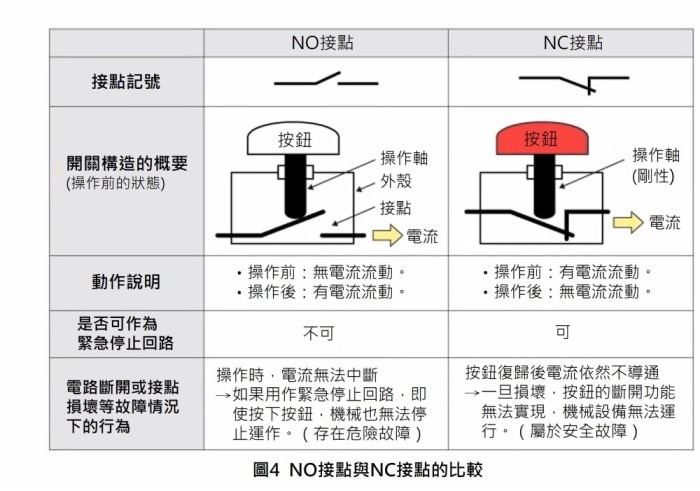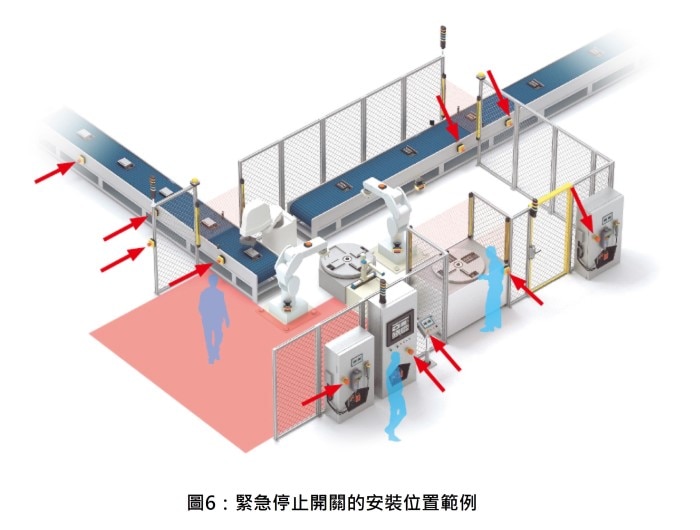在用於工廠等處的機械設備,有搭載為確保作業員安全,能讓機械設備緊急停止動作的「緊急停止系統」【圖1】。
做為此系統的輸入部份而設置的零件就是緊急停止開關。當作業員感到危險或是機械設備發生異常時,能以手動進行操作的開關【圖2】。
- 首頁
- 何謂緊急停止開關
解決方案
降本增效
小型控制設備
小型控制設備
LED照明裝置
LED照明裝置
可程式控制器
可程式控制器
程式軟體、機種選型系統
程式軟體、機種選型系統
長使用壽命的控制設備
長使用壽命的控制設備
降本增效
減碳排放
PID控制/熱氣工程技術
PID控制/熱氣工程技術
實現高效供電
實現高效供電
LED照明裝置
LED照明裝置
12VDC型PLC
12VDC型PLC
減碳排放
安全與未來
協同安全
協同安全
安全2.0
安全2.0
第3代緊急停止開關
第3代緊急停止開關
機械安全
機械安全
功能安全
功能安全
安全諮詢
安全諮詢
追蹤系統
追蹤系統
安全與未來
電池生產的無銅化
電池生產的無銅化
降低停機時間
長使用壽命且耐久性卓越的設備
長使用壽命且耐久性卓越的設備
遠程監視、控制
遠程監視、控制
預測性·預防性維護
預測性·預防性維護
更換簡單
更換簡單
避免因事故引發停機時間
避免因事故引發停機時間
降低停機時間
工業物聯網優化作業
一鍵檢查
一鍵檢查
掃描產品
掃描產品
使用智能設備
使用智能設備
利用感測器
利用感測器
工業物聯網優化作業
防爆
遠程監控
遠程監控
機械安全
機械安全
減少維修
減少維修
可追溯性
可追溯性
專業支援
專業支援
防爆
解決勞動力短缺
防爆結構攝影鏡頭
防爆結構攝影鏡頭
運用工業機器人
運用工業機器人
遠程監視、控制
遠程監視、控制
預防性維護
預防性維護
預測性維護
預測性維護
自動化
自動化
解決勞動力短缺
- 降本增效
- 小型控制設備
- 小型控制設備
- LED照明裝置
- LED照明裝置
- 可程式控制器
- 可程式控制器
- 程式軟體、機種選型系統
- 程式軟體、機種選型系統
- 長使用壽命的控制設備
- 長使用壽命的控制設備
- 降本增效
- 減碳排放
- PID控制/熱氣工程技術
- PID控制/熱氣工程技術
- 實現高效供電
- 實現高效供電
- LED照明裝置
- LED照明裝置
- 12VDC型PLC
- 12VDC型PLC
- 減碳排放
- 安全與未來
- 協同安全
- 協同安全
- 安全2.0
- 安全2.0
- 第3代緊急停止開關
- 第3代緊急停止開關
- 機械安全
- 機械安全
- 功能安全
- 功能安全
- 安全諮詢
- 安全諮詢
- 追蹤系統
- 追蹤系統
- 安全與未來
- 電池生產的無銅化
- 電池生產的無銅化
- 降低停機時間
- 長使用壽命且耐久性卓越的設備
- 長使用壽命且耐久性卓越的設備
- 遠程監視、控制
- 遠程監視、控制
- 預測性·預防性維護
- 預測性·預防性維護
- 更換簡單
- 更換簡單
- 避免因事故引發停機時間
- 避免因事故引發停機時間
- 降低停機時間
- 工業物聯網優化作業
- 一鍵檢查
- 一鍵檢查
- 掃描產品
- 掃描產品
- 使用智能設備
- 使用智能設備
- 利用感測器
- 利用感測器
- 工業物聯網優化作業
- 防爆
- 遠程監控
- 遠程監控
- 機械安全
- 機械安全
- 減少維修
- 減少維修
- 可追溯性
- 可追溯性
- 專業支援
- 專業支援
- 防爆
- 解決勞動力短缺
- 防爆結構攝影鏡頭
- 防爆結構攝影鏡頭
- 運用工業機器人
- 運用工業機器人
- 遠程監視、控制
- 遠程監視、控制
- 預防性維護
- 預防性維護
- 預測性維護
- 預測性維護
- 自動化
- 自動化
- 解決勞動力短缺
何謂緊急停止開關 | 台灣

緊急停止開關的構造
按鈕顏色與形狀
在機械設備的操作面板上,通常會排列著許多的操作按鈕或儀表。
緊急停止開關在這些元件當中,在緊急時也必須要能立即被辨識出來。因此,緊急停止開關的操作按鈕外觀被要求設計為大顆的、紅色的,且用手掌容易按壓的蘑菇頭造型。此外,還需將開關的周邊以黄色進行搭配使緊急停止開關更加醒目【圖3】。
NC(Normal Close:常閉)型的輸出接點
開關的接點可以分為Normal Open(NO:常開)型與Normal Close(NC:常閉)型兩種【圖4】。而緊急停止開關,被要求一定要使用NC型的接點(NC接點)。其理由說明如下。
讓我們思考一下如果我們如【圖4】左側所示,誤將常開型接點(NO接點)用於緊急停止按鈕開關會發生什麼情況?此時,當按鈕未被按下(即未處於緊急狀態)時,NO接點保持開路狀態,因此回路中不會有電流流動。然而,當按下按鈕時,NO接點閉合,電流便會流入回路,觸發機械設備的緊急停止功能。但如果NO接點上附著異物,或配線斷裂等回路發生異常情況,回路中不會有電流流動,導致即使按下按鈕,也無法使機械設備停機,因此引發危險側故障。
另一方面,如果我們如【圖4】右側所示,將NC接點作為緊急停止按鈕的話,當按鈕未被按下時,接點是保持閉合的狀態。在此情況下,由於NC接點閉合,回路中會有電流流動,表示機械設備處於安全狀態。當按下按鈕時,NC接點會打開,進而切斷電流,觸發機械設備的緊急停止。也就是說,緊急停止按鈕所發出的緊急停止信號,是透過切斷原本流動的電流(代表安全狀態)來實現的。
然而,若NC接點上附著異物或配線中斷等回路異常情況發生,回路中將無法正常流動電流,這將導致無法啟動機械設備,因此引發安全側故障。
如上所述,在NO接點和NC接點之間,當回路發生異常時,其故障狀態會有所不同。 從安全性的角度來看,哪種故障狀態更為理想呢?
對於像緊急停止按鈕開關這類用於與安全相關的控制系統的元件,要求其在自身發生故障時,會導致機械停止的「安全側故障」。因此,根據規範,緊急停止按鈕開關必須使用NC接點。

直接開路動作機能
直接開路動作機能是指按鈕按下的力量能確實傳遞至NC(常閉)接點,使其打開的功能。即使接點發生 ※熔著 的情況,按下按鈕後也能確保將NC接點打開。
因此,從圖4右側圖示中的操作「按鈕」到「接點」,必須全部由具有剛性的硬質零件構成。
無法使用彈簧等彈性零件來傳遞按鈕按下的力量,因為如果彈簧等彈性零件發生損壞,按下按鈕也無法打開NC接點。
※熔著 因超出接點容量的電流通過導致接點相互融解,並造成接點難以分離的現象。
鎖定機構(自我保持機構)
一般來說,緊急停止用按鈕開關是在緊急情況下操作。當按下按鈕時,NC(常閉)接點會打開並切斷電流,同時鎖定機構會啟動,將按鈕保持在按下的位置。 透過這種結構,可以維持電流中斷狀態,從而防止機械設備的意外重新啟動。
在確認安全後,有兩種方法可以解除鎖定並將按鈕恢復到原始位置:1.旋轉復歸型(Turn Reset Type):按指定方向旋轉按鈕。拉出復歸型(Pull Reset Type):將按鈕拉回原位。需要注意的是,不同地區使用的復歸方式可能有所不同。因此,為了適應所有地區的需求,還有一種兼容型設計,既可以旋轉復歸,也可以拉出復歸。【圖5】。
緊急停止按鈕開關 X系列產品介紹
安裝場所
緊急停止用按鈕開關需要依照安全標準規範要求設置在機械設備的以下位置:
● 根據風險評估的結果,設置於必要的位置。
● 設置於各操作面板上。(除非風險評估結果顯示不需要)
● 設置於機械設備的出入口部分。
● 設置於需要操作人員進行機械介入操作的地方,例如具有「保持運作」控制功能或啟用控制功能的地方。
● 設置於所有可能發生操作人員與機械干涉的地方,例如工件的輸入/輸出口等位置。
